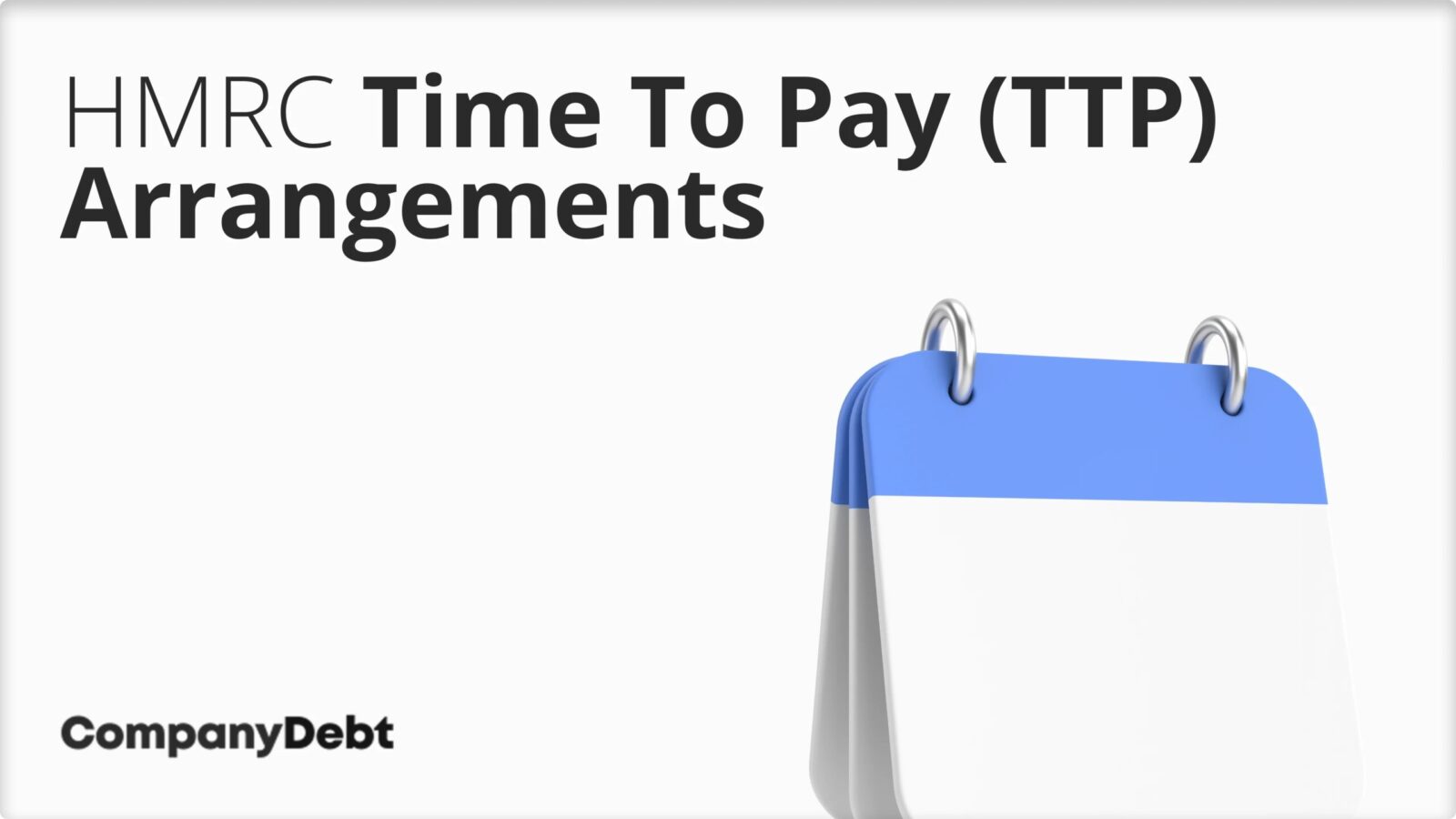
HMRC Time to Pay Arrangements (TTP)
Understanding HMRC payment plans, including how to arrange one, the criteria, and a range of FAQs.
- What is an HMRC Time to Pay Arrangement?
- Who is Eligible for a Time to Pay Arrangement?
- How do I Apply?
- Negotiating Time to Pay (TTP) with HMRC
- Do HMRC Charge Interest?
- Can HMRC Refuse a Payment Plan?
- Can I Arrange TTP Arrangements for Longer than 12 Months?
- What Types of Tax can be Included in a Time to Pay Arrangement?
- What Happens if I Miss a Payment Under a Time to Pay Arrangement?
- Expert Advice and Next Steps
- FAQs on Time to Pay Arrangements
What is an HMRC Time to Pay Arrangement?
An HMRC Time to Pay (TTP) Arrangement is an agreement made between a business and HM Revenue & Customs to pay outstanding tax liabilities via an instalment plan.
These agreements are designed to provide more breathing space for a company experiencing financial difficulty and improve cash flow problems.
Key features:
- Typically lasts up to 12 months
- Requires ongoing taxes to be paid on time
- May be withdrawn if terms are breached
In my experience, the key to negotiating a TTP with HMRC is good communication, providing detailed information, being consistent and transparent with what you tell them, and using experienced negotiators if you’re dealing with substantial liabilities.

Pros and Cons of a Time to Pay Arrangement
Pros
- TTPs allow better cash flow management by spreading tax payments over a period.
- Avoids penalties and surcharges
- Help avert legal action and formal insolvency procedures.
- Enables more accurate financial planning with predictable monthly outgoings.
- Corporation tax, VAT and PAYE payments can be included in the agreement
Cons
- Will result in interest charges, increasing the overall amount paid.
- Requires strict adherence to payment terms, with little room for error.
- They might not grant you the TTP if you operate in a high risk industry.
- A TTP might lead to increased scrutiny from HMRC on future tax affairs.
Who is Eligible for a Time to Pay Arrangement?
As a business owner, you may be wondering if your company qualifies for HMRC’s Time to Pay (TTP) arrangement. HMRC typically considers your business eligible if:
- Your business is viable but facing temporary financial challenges
- You can demonstrate the ability to meet the proposed repayment terms
- You have a realistic plan to clear tax debts, usually within 12 months
- Your business maintains a good compliance history without previous TTP defaults
Remember, HMRC evaluates each case individually. Your specific circumstances will influence their decision.
How do I Apply?
Applying for a Time to Pay (TTP) arrangement with HMRC is a straightforward process[1]Trusted Source – GOV.UK – Setting up a payment plan. To get started, you’ll need to provide the following information:
- Your tax reference number
- UK bank account details for Direct Debit setup
- Details of any missed payments
During your discussion with HMRC, be prepared to answer questions about your financial situation. They may ask about any savings you have, as they’ll expect you to use these first to reduce your debt.
For VAT debts of £50,000 or less, HMRC offers a convenient If you have a VAT debt of £50,000 or less, you can set up an online VAT payment plan option. This can simplify the process for eligible businesses.
Negotiating Time to Pay (TTP) with HMRC
When starting negotiations with HMRC for a TTP, I advise you to prepare thoroughly.
- Begin the conversation by clearly outlining your company’s financial situation and how it led to the outstanding liabilities. Be transparent and provide evidence to support your statements.
- Be prepared to discuss your proposed repayment schedule in detail. This includes how much you can afford to pay monthly, how long you will need to clear the debt, and any steps to ensure your company’s financial stability.
- If you’re unsure how to approach the negotiation or prepare the necessary documentation, consider seeking advice from a licensed insolvency practitioner such as ourselves. We can offer valuable insight into the process, help prepare your proposal, and even negotiate on your behalf.
Do HMRC Charge Interest?
Yes, HMRC charges interest on late and early payments per their current guidance document.
Can HMRC Refuse a Payment Plan?
HMRC can certainly refuse a payment plan.
There are no set criteria, but you must have a convincing argument for why you can’t pay your tax bill on time and how you will pay them back. They will want to see evidence of your ongoing expenses and projected income.
Ultimately, they want to hear commitment and determination on your part to pay them back in full.
HMRC will undoubtedly insist on a direct debit for your monthly instalments.
If you have had a TTP arrangement in the past, this does not preclude you, but it does make you less likely to be accepted.
Can I Arrange TTP Arrangements for Longer than 12 Months?
The HMRC website states they will not accept payment outside of twelve months unless there are exceptional circumstances (such as COVID-19). They also refuse to negotiate the amount owed to a reduced settlement figure.
What Types of Tax can be Included in a Time to Pay Arrangement?
HMRC can offer you up to a year to pay back your VAT, Corporation Tax or PAYE arrears in instalments, though no longer than this except in exceptional circumstances. Be aware HMRC may want the arrears repaid in a shorter period.
What Happens if I Miss a Payment Under a Time to Pay Arrangement?
HMRC’s flexibility will likely end abruptly if you fail to adhere to a payment plan you’ve already negotiated. If you don’t make your agreed payments, they will probably cancel the Time to Pay Arrangement and possibly impose a penalty.
You want to avoid this situation at all costs because it may provoke legal action.
The legal action could result in a Distraint Order Notice, in which HMRC announces its intention to enter your property and seize your company’s possessions or serve a winding-up petition on the company[2]Trusted Source – GOV.UK – Getting a winding-up order. If upheld by the judge, this imposes a compulsory liquidation of the company and can have severe consequences for directors.

Expert Advice and Next Steps
If your Time to Pay arrangement proposal has been refused by HMRC, or you’re facing overwhelming pressure from their Debt Management team, it’s crucial to seek expert guidance promptly. At Company Debt, our team of licensed insolvency practitioners has decades of experience helping companies navigate these challenging situations.
We understand that every case is unique, and we’ll work closely with you to assess your specific circumstances and explore all available options. Whether it’s re-negotiating with HMRC, considering alternative repayment strategies, or exploring formal insolvency procedures, we’ll provide clear, practical advice tailored to your needs.
Our team has an extensive track record of successfully resolving HMRC debt issues, and we’re committed to protecting your interests and finding the best possible outcome for your company. We offer a free, confidential consultation to discuss your situation and provide expert recommendations on the best way forward.
Call us now on 0800 074 6757 to speak directly with one of our knowledgeable advisors, or use our live chat service during working hours for immediate assistance.
FAQs on Time to Pay Arrangements
Can I set up a Time to Pay Arrangement for my personal tax liabilities, such as Self-Assessment?
Yes, HMRC Time to Pay Arrangements are not limited to business taxes. If you are facing difficulties paying your personal tax debts, such as Self-Assessment, you can contact HMRC to discuss setting up a TTP for these liabilities as well.
Can I include future tax liabilities in my Time to Pay Arrangement?
No, Time to Pay Arrangements are designed to help with existing tax debts. You cannot include future tax liabilities in the agreement.
What happens if my financial situation improves during the course of my Time to Pay Arrangement?
If your financial situation improves during your TTP, it is advisable to contact HMRC and discuss the possibility of settling your outstanding tax debts earlier than originally agreed. This can help you save on interest charges and demonstrate your commitment to paying your tax liabilities.
Are there any fees associated with setting up a Time to Pay Arrangement with HMRC?
HMRC does not charge any fees for setting up a Time to Pay Arrangement. However, as mentioned in the article, interest will accrue on your outstanding tax debts for the duration of the arrangement, so it is important to factor this into your repayment plan.
The primary sources for this article are listed below, including the relevant laws and Acts which provide their legal basis.
You can learn more about our standards for producing accurate, unbiased content in our editorial policy here.
- Trusted Source – GOV.UK – Setting up a payment plan
- Trusted Source – GOV.UK – Getting a winding-up order








